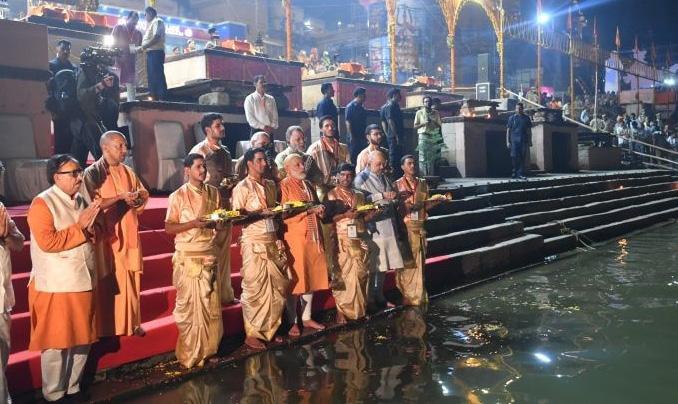
7 minute read
Benares: Karma, Destiny and Freewill!
Uttam Sinha and Manoj Mishra
As you trudge through the narrow lanes and descend the slippery stone steps to the ghats where its edges touch the ripples of Ganga, you stop and look to the reverend river and turn behind to the heap of mismatched temples and then, suddenly, the mystery of life engulfs you. It is an epiphanic moment like the Yaksha Prashna to Yudhisthira in the epic Mahabharata, “And what is the greatest wonder”, to which the virtuous Yudhisthira answers: “Each day death strikes and we live as though we were immortal. This is the greatest wonder.” Benares is that puzzling city; a city of existence and continuity, one of palpable intensity that is forever alluring and perplexing — the enchanting city to wash away your sins and to die in. It is a city you need to know everything about but end up only discovering a million more facets to it; where one convincing story leads to another equally compelling one. The city strains, so to speak, under its own myth; hard to prove but difficult to not believe. And flows the prose But more than anything else Benares is a city of fascinating juxtaposition that immediately instructs and even shocks. The “play of life and death” in the ghats and in the mandirs starts with the break of dawn and lingers into the deep night with hanging smoke from the pyres. It’s an ancient Hindu city, which is as holy for the Muslims and continues its cheek-by-jowl existence with Islamic and Hindu traditions. The charm and mystique of Benares has attracted people from far and away and left an indelible impression. Mark Twain, one of 20th century’s greatest cultural critics, on his subcontinental sojourn between January and April 1896 confesses: “If you go to Benares with a serious desire to spiritually benefit yourself, you will find it valuable.” He almost never stops describing the city in his book Following the Equator: A Journey Around the World (1897) and saying: “Benares is older than history, older than tradition, older even than legend and looks as twice as old as all of them put together”. Interestingly, Twain informs and appreciates getting valuable facts from reading Rev Mr Parker’s Guide to Benares of which little is known. While the prose has always flowed in Benares like a muse to an inspired writer; the lens too has been captivated by the surreal expression of the city. Herbert Ponting, acclaimed for his enduring images of the Antarctic from 1910 to 1913, could not resist capturing the sadhus, sants and fakirs on the ghats and the melancholic presence of the havelis in the gullies of Benares. Cultural chronicle and centre of learning Benares is also a cultural epicentre, a confluence of religion and faith, and a history of tolerance and co-existence that has seen Persian culture and Islamic traditions flourish. There can be nothing more syncretic than to find a Sufi Muslim shrine of Bahadur Saheed visited by thousands of Hindus and Sikhs and Christians. It is hardly surprising that Benares has been chronicled by historians, sociologist, satirists, poets, novelists and ethnographers. One has to put all the mythological, historical, anthropological, archaeological and proto-history together to unravel the city’s past. That’s why conflicting schools of philosophy have positioned for intellectual acceptance here through the language (Hindi and its dialect awadhi) that is common and involves larger participation. While many cities have more than a few names, Benares has a hundred or probably even more. Though officially Varanasi (the secret land between the rivers Varuna and Assi that join the Ganga), the locals proudly call it Benares, after the mythological ruler Benar or simply the making of sweetness or joy (ras). Another name ‘Kashi’ (city of light) carries cultural weight. Mentioned in ancient Buddhists texts around the first millennium BC as a great kingdom, Kashi has a resonance of universal knowledge and wisdom. The city’s belief, myth and spiritual power are collectively captured on the ghats that line the west bank of Ganga. Each of the 84 ghats from north to south stretching for over seven kilometres are fantastically photogenic and delightfully architectural but also sees the unfolding of day-to-day life of a multitude of people. The ghats are a lifeline, in fact the only public space in Benares and one can also see the akhadaas (a traditional gym for athletes and martial arts), yet another distinctive feature of Benares. Each ghat has a character about it and a tale to tell. Benarasipan Benares has lived through many folklore and metaphors such as Ganga-Jamuni tehzeeb and Tana Bana. The former compares the Hindu-Muslim harmony and friendship to the holy confluence of India’s major rivers, the Ganga and Yamuna, and the peaceful merging of the culture and lifestyle, joint festivities and interdependence. As such Benares reminds people of the incomparable unison of the two communities that share the city space. There is community bonding rather than religious segregation. The other peace metaphor that is unique to Benares is the Tana-Bana (weaving of the silk sari), which describes the interdependent and easy-going communal existence between the Hindus and Muslims — as interlinked like the warp and weft of a Benarasi silk sari. Tana-Bana emphasises salience of business and that harmony between Hindus and Muslims are not only a matter of their personal consciousness but are also driven by their social being. The Muslims constitute one-quarter of the population, which is substantially large as compared to other cities, and significantly contribute to the local economy. The other ethos which is very popular in the city life is that of ‘Benarasipan’. It is an over-arching collective identity, which loosely translated means a “free-spirited soul with a heart of gold”. This ‘Benarasipan’ accompanied with mauj-masti (leisure and pleasure) appear to support a unique lifestyle in the city and serves as a frame for the inter-faith activities. In the eye of politics Benares has always been politically alive and a seat from Kashi is regarded as a prized one — a representative from the spiritual and cultural capital. Like in most constituencies, politics is not above caste or religion in Benares. Despite the charged atmosphere and the cutthroat campaign, Benares retained its sanity and cohesiveness, allowing the city’s free spirit to prevail and “a thousand flowers to bloom”. Benares has had its political figures but none more towering than the Prime Minister Narendra Modi. Benares also gave Madan Mohan Malaviya, an enlightened personality. Respectfully called Mahamana, he would frequently advice those aspiring to be in politics that “The path of politics is strewn with struggles. And remember, if you want to be in politics never let your selfinterests get the better of you.” His groundings in the tenets of Hindu Dharma led him to strong beliefs on ‘right thinking and right actions’. And it was his vision and great determination that he eventually built the renowned Benaras Hindu University (BHU) in 1916. As the president of the India National Congress four times, he moderated successfully between the liberals and the nationalists and the moderates and the extremists. It is often recollected that when Malaviya was on his deathbed, he said, “Take me to the outskirts of Benares”. Puzzled, the people by his side asked as to why and he replied, “My work on earth is not complete, I do not want to achieve moksha. I must come back and finish my work.” Uttam Kumar Sinha is works at the Manohar Parrikar Institute for Defence Studies and Analyses and Manoj Kumar Mishra teaches at the Malaviya Centre for Peace Research, BHU
Advertisement
(This is an edited version of the article that first appeared in Sunday Pioneer, May 18, 2014)

Prof. Manoj Kumar Mishra

Uttam Sinha










